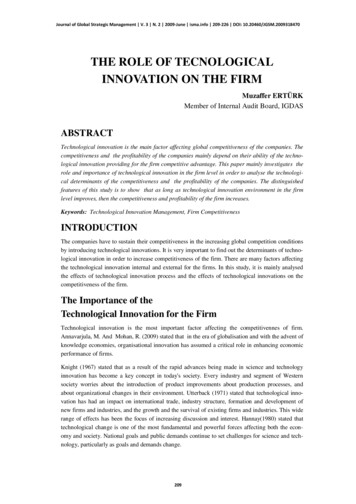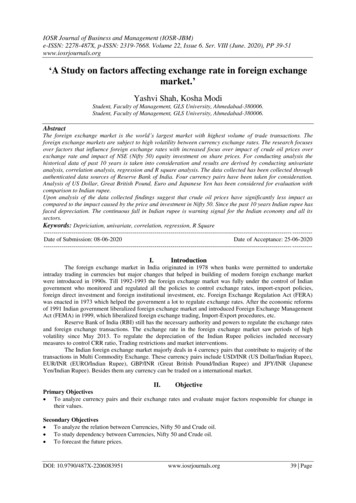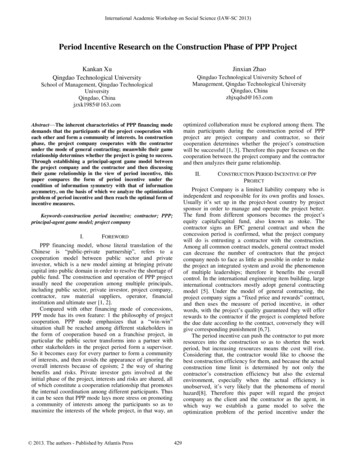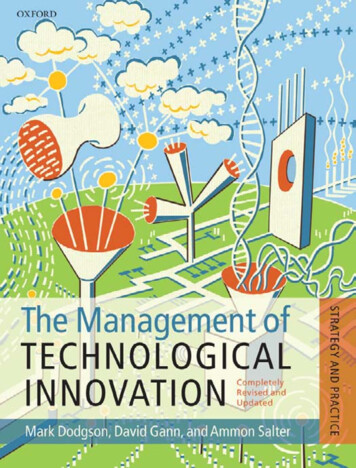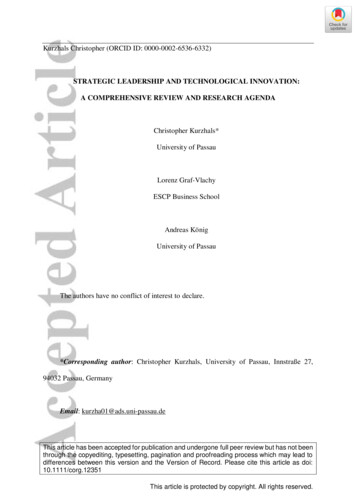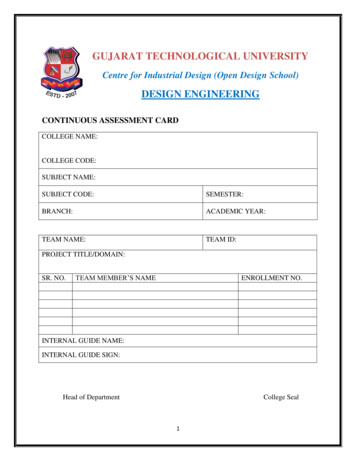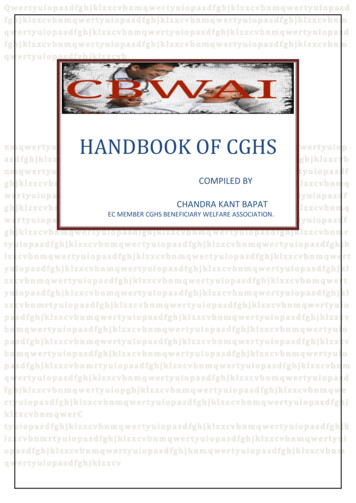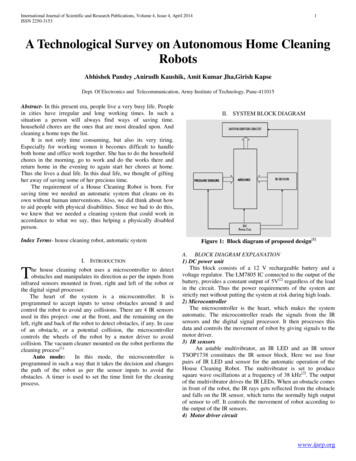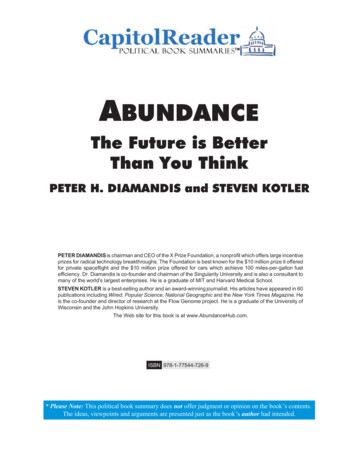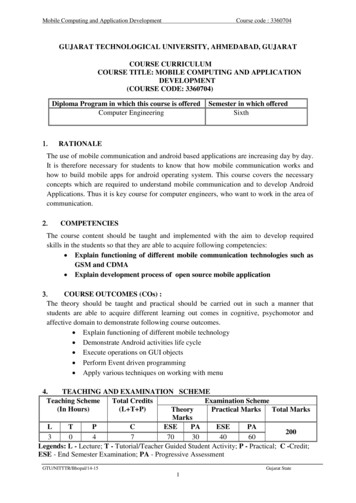
Transcription
Mobile Computing and Application DevelopmentCourse code : 3360704GUJARAT TECHNOLOGICAL UNIVERSITY, AHMEDABAD, GUJARATCOURSE CURRICULUMCOURSE TITLE: MOBILE COMPUTING AND APPLICATIONDEVELOPMENT(COURSE CODE: 3360704)Diploma Program in which this course is offeredComputer Engineering Semester in which offeredSixthRATIONALEThe use of mobile communication and android based applications are increasing day by day.It is therefore necessary for students to know that how mobile communication works andhow to build mobile apps for android operating system. This course covers the necessaryconcepts which are required to understand mobile communication and to develop AndroidApplications. Thus it is key course for computer engineers, who want to work in the area ofcommunication. COMPETENCIESThe course content should be taught and implemented with the aim to develop requiredskills in the students so that they are able to acquire following competencies: Explain functioning of different mobile communication technologies such asGSM and CDMA Explain development process of open source mobile application COURSE OUTCOMES (COs) :The theory should be taught and practical should be carried out in such a manner thatstudents are able to acquire different learning out comes in cognitive, psychomotor andaffective domain to demonstrate following course outcomes. Explain functioning of different mobile technology Demonstrate Android activities life cycle Execute operations on GUI objects Perform Event driven programming Apply various techniques on working with menu4.TEACHING AND EXAMINATION SCHEMETeaching SchemeTotal CreditsExamination Scheme(In Hours)(L T P)TheoryPractical MarksTotal MarksMarksLTPCESEPAESEPA200304770304060Legends: L - Lecture; T - Tutorial/Teacher Guided Student Activity; P - Practical; C -Credit;ESE - End Semester Examination; PA - Progressive AssessmentGTU/NITTTR/Bhopal/14-15Gujarat State1
Mobile Computing and Application Development5.Course code : 3360704COURSE CONTENT DETAILSUnitUnit – IIntroductionto MobileComputingMajor Learning Outcomes(in cognitive domain)1a.Explain brief Introductionto Mobile technology andgenerations1b.Defineandexplaincharacteristics of GSM andCDMA1c. Explain services andarchitecture of GSM ANDMobile Computing1d. Explain characteristics ,Application & Securityissue of MobileComputing1c. Explain Middleware andGateway for MobileComputing1d. Explain Mobile IP andmobile CommunicationProtocol1e. Introduction to MobilecomputingthroughtelephonyTopics and Sub-topics1.1 Concept of Mobile Communication1.2 Different generations of wirelesstechnology1.3 Basics of cell, cluster and frequencyreuse concept1.4 Noise and its effects on mobile1.5 Understanding GSM and CDMA1.6 Basics of GSM architecture andservices like voice call, SMS, MMS, LBS,VAS1.7 Different modes used for MobileCommunication1.8 Architecture of Mobile Computing(3tier)1.9 Design considerations for mobilecomputing1.10 Characteristics of MobileCommunication1.11 Application of MobileCommunication1.12 Security Concern Related to MobileComputing1.13 Middleware and Gateway requiredfor mobile Computing1.15 Making Existing Application MobileEnable1.16 Mobile IP1.17 Basic Mobile Computing Protocol1.18 Mobile Communication via Satellite Low orbit satellite Medium orbit satellite Geo stationary satelliteSatellite phonesUnit – IIIntroductionto Android2a. Analyze Open source2.1 Overview of Androidmobile technology,2.2 What does Android run On – AndroidExplain Basics ofInternals?Application development2.3 Android for mobile apps development2b. Explain Framework, SDK, 2.5 Environment setup for Android appsEmulationDevelopment2c. Explain Android2.6 Framework - Android- SDK, EclipseApplication structure2.7 Emulators – What is an Emulator /Android AVD?GTU/NITTTR/Bhopal/14-15Gujarat State2
Mobile Computing and Application DevelopmentMajor Learning Outcomes(in cognitive domain)UnitUnit – IIIAndroidActivities andGUI DesignConceptsUnit – IVAdvanced UIProgrammingUnit – VToast, Menu,Dialog, Listand AdaptersCourse code : 3360704Topics and Sub-topics2.8 Android Emulation – Creation and setup2.9 First Android Application3.1 Design criteria for AndroidApplication : Hardware DesignConsideration, Design Demands ForAndroid application, Intent, Activity,Activity Lifecycle and Manifest3.2 Creating Application and newActivities3.3 Simple UI -Layouts and Layoutproperties :Introduction to AndroidUI Design, Introducing Layouts3.5 XML Introduction to GUI objectsviz.: Push Button , Text / Labels ,EditText, ToggleButton , Padding3a. Explain AndroidActivities lifecycle and UILayout3b. Explain Expressions,Manifest, other necessaryUI concept3c.List and explain GUIObjects,3d. Explain Layout Designconcepts4a. Explain Android Eventdriven Programming,Activity Lifecycle, ExplainException handling5a.Demonstrate working withmenu and dialog, Themes,Dialog5b.Perform Demo ApplicationLaunching5c Perform Databaseoperation4.1 Event driven Programming in Android(Text Edit, Button clicked etc.)4.2 Activity Lifecycle of Android5.1 Menu :Basics, Custom v/s SystemMenus, Create and Use Handset menuButton (Hardware)5.2 Dialog : Creating and Altering Dialogs5.3 Toast : List & Adapters5.4 Demo Application Development andLaunching5.5 Basic operation of SQLite Database5.6 Android Application Priorities6. SUGGESTED SPECIFICATION TABLE WITH HOURS & MARKS (THEORY)UnitNo.Unit TitleTeachingHoursIIIIIIIntroduction to Mobile ComputingIntroduction to AndroidAndroid Activities and GUIDesign concepts.Advanced UI ProgrammingToast, Menu, Dialog, List tribution of Theory gends: R Remember; U Understand; A Apply and above levels (Bloom’s revised taxonomy)GTU/NITTTR/Bhopal/14-15Gujarat State3
Mobile Computing and Application DevelopmentCourse code : 3360704Note: This specification table shall be treated as a general guideline for students and teachers.The actual distribution of marks in the question paper may vary slightly from above table.7. SUGGESTED LIST OF EXERCISES/PRACTICALThe practical/exercises should be properly designed and implemented with an attempt todevelop different types of skills (outcomes in psychomotor and affective domain) so thatstudents are able to acquire the competencies/programme outcomes. Following is the list ofpractical exercises for guidance.Note: Here only outcomes in psychomotor domain are listed as practical/exercises. However,if these practical/exercises are completed appropriately, they would also lead to developmentof certain outcomes in affective domain which would in turn lead to development of CourseOutcomes related to affective domain. Thus over all development of Programme Outcomes(as given in a common list at the beginning of curriculum document for this programme)would be assured.Faculty should refer to that common list and should ensure that students also acquireoutcomes in affective domain which are required for overall achievement of ProgrammeOutcomes/Course 112IIIIIIIIIIIIIIIIIIPractical ExercisesInstallation and setup of java development kit(JDK),setup androidSDK,setup eclipse IDE,setup android development tools (ADT)plugins,create android virtual deviceCreate “Hello World” application. That will display “Hello World” in themiddle of the screen using TextView Widget in the red colorCreate application for demonstration of android activity life cycleHrs.Required442Create Registration page to demonstration of Basic widgets availablein android.Create sample application with login module.(Check username andpassword) On successful login, Chnage TextView “Login Sucessful”. Andon failing login, alert user using Toast “Login fail”Create login application where you will have to validate usename andpasswords Till the username and password is not validated , login buttonshould remain disabled.Create and Login application as above. Validate login data and displayError to user using setError() method.Create an application for demonstration of Relative and Table Layout inandroid.4Create an application for demonstration of Scroll view in android24444Create an application for demonstration of Explicitly Starting New Activity 2using Intent.Create an application that will pass two number using TextView to the next 4screen , and on the next screen display sum of that number.Create spinner with strings taken from resource folder(res value folder). 4On changing spinner value, change background of screen.GTU/NITTTR/Bhopal/14-15Gujarat State4
Mobile Computing and Application Development13IV14IV15V16VCourse code : 3360704Create an application that will get the Text Entered in Edit Text anddisplay that Text using toast (Message).Create an application that will Demonstrate Button onClick() Event andchange the TextView Color based on button ClickedCreate an UI such that, one screen have list of all the types of cars. Onselecting of any car name, next screen should show Car details like: name,launched date, company nameCreate an application that will Demonstrate Dialog Box Control In AndroidTotal hour8.444458SUGGESTED STUDENT ACTIVITIESFollowing is the list of proposed student activities such as:i.Design sample GUIii. Prepare and Present presentation on different mobile technology and on OpenSource Technologyiii. Prepare comparison of technical features of different mobile communicationTechnologies being used by popular service providers (such as VSNL, Reliance,Vodafone, Idea etc.) in your city/town9. SPECIAL INSTRUCTIONAL STRATEGIES (if any)i. Faculty should demonstrate an Open source technology specifically java and shouldgive some clear understanding of mobile technology using some simulation orpictorial representation.ii. Concepts should be introduced in classroom input sessions and by giving demonstrationthrough projector.iii. More focus should be given on practical work which will be carried out in laboratorysessions. If possible some theory sessions may be conducted in labs so that theory andpractice can go hand in hand.iv. Group Discussion and presentation of related websites should be arranged.v. Faculty should allow students to use their creativity and during practical sessions letthem struggle to learn on their own. However, faculty should remain around thestudents and should help them when they are stuck.10. SUGGESTED LEARNING RESOURCES List of BooksSr.No.Title of BookAuthorPublication1Building Android AppsIN EASY STEPSMcGraw-Hill Education2Reto MeierWiley India Pvt Ltd3Professional Android 2Application DevelopmentBeginning AndroidMark L MurphyWiley India Pvt Ltd4Pro AndroidSayed Y Hashimi andSatya KomatineniWiley India Pvt LtdGTU/NITTTR/Bhopal/14-15Gujarat State5
Mobile Computing and Application DevelopmentCourse code : 3360704Suggested Readings:i. Android Studio Development Essentials by Neil Smythii. The Definitive Guide to SQL Lite by Michael Owens List of Major Equipment/ Instrument with Broad Specificationsi.ii.Hardware: Necessary Kits or Environment to briefly introduce mobiletechnology environment like GSM, CDMA and GSM services, Computerwith latest configurationSoftware: Java, Netbeans, Eclipse, Android SDK (open source)C) Additional Resources of MIS that can be used for conducting Practical as well ascase com/android/android sics/firstappCOURSE CURRICULUM DEVELOPMENT COMMITTEEFaculty Members from Polytechnics Prof. P. P. Kotak, H. O. D Computer Department, A. V. P. T. I., Rajkot Prof. R. M. Shaikh, H.O.D Computer Department, K. D. Polytechnic, Patan Prof. K. N. Raval, H.O.D Computer Department, R. C. Technical Institute,Ahmedabad Prof. S. R. Solanki, Lectuer Computer, Government Polytechnic, Dahod Prof. R. B. Pancholi, Lectuer Computer, L. J. Polytechnic, Ahmedabad. Prof. J. L. Vyas, Lectuer Computer, L. J. Polytechnic, Ahmedabad.Coordinator and Faculty Members from NITTTR Bhopal Dr M A Rizvi, Associate Professor, Department of Computer Engineering andApplications.Dr R K Kapoor, Associate Professor, Department of Computer EngineeringApplications. .GTU/NITTTR/Bhopal/14-15Gujarat State6
II Installation and setup of java development kit(JDK),setup android SDK,setup eclipse IDE,setup android development tools (ADT) plugins,create android virtual device
